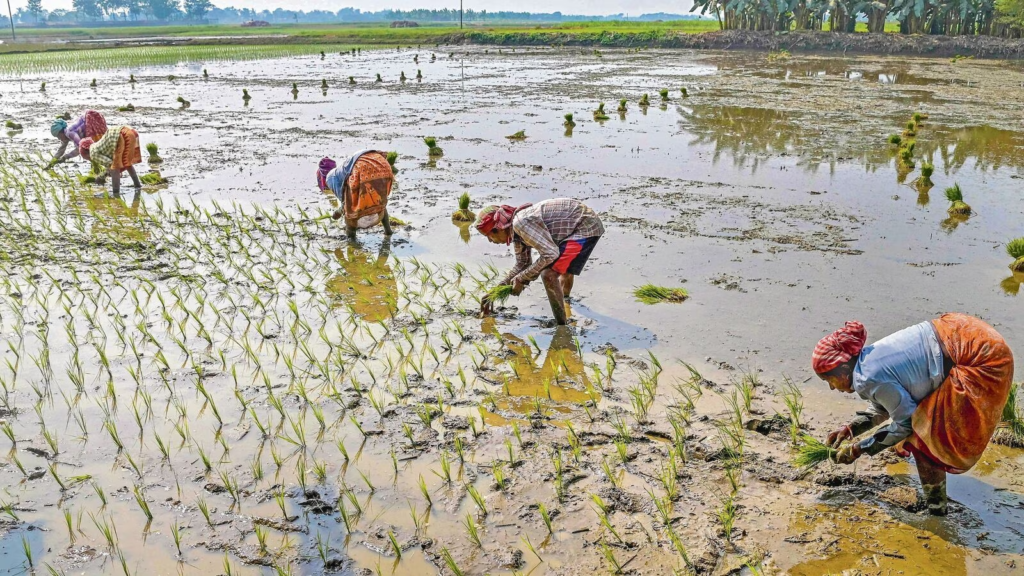The MSP Conundrum: Farmers Struggle Amidst Policy Debates

Image Source: Mint
MSP was first introduced in the 1960s. Since then, there has been a debate on improving the MSP system at regular intervals, with the Swaminathan Commission being one of the prime examples. The Swaminathan Commission was formed in 2004 and submitted its final report in 2006, highlighting a bulk of changes that should be made to help the farmers.
What is the problem in the present MSP system?
MSP is the price of agricultural produce necessary to keep agricultural finances viable. MSP does not consider the profitable value of agricultural produce, which is necessary for a normal farmer to sustain his life in the long run. So, if the farmer does not get MSP with profit in mind, the farmer will eventually be pushed down into debt. According to reports, only 6 percent of farmers in the country benefit from MSP.
For example, as per the definition of MSP, if a farmer spends 100 rupees on the process of growing a crop and the MSP for the crop is set at rupees 100, then how is it helping the farmer? The farmer was banking on the profit that would incur on the produce of the crop to meet his expenses for the entire year. So, even after getting the MSP, the farmer will be left with two options: whether to use the money for production again or use that money for survival, which forces the farmer to take a loan and get burdened.
So, MSP should be calculated over the entire profitable value of the produce to motivate the farmers to earn more and produce more.
The livelihood of 50 percent of the national population depends on Agri-related activities. It is by far the largest source of employment in the country. According to NABARD (National Bank for Agricultural and Rural Development), in 2019, the average debt on farmers is about a lakh rupees despite the government giving 3.36 lakh crores as a subsidy.
Changes that can be made to help the farmers are as follows:
Firstly, we all have to accept the fact that farmers are not machines to increase crop production but also humans. So, the agricultural policy of the country should not only be production-centric but also farmer-centric.
The burden of providing cheap grains should not only be the duty of farmers; the government should help in the process. Very often, farmers sell their produce at low prices to please the consumer.
Farmers do not get the rate that is way lower than the rate at which the produce is originally sold to the consumer in the market due to various middlemen in the process. Therefore, the government should make sure that the process is thoroughly regulated.
Environmental Challenges Compound Farmer Struggles
As global warming and climate change intensify, farmers find themselves grappling with additional challenges. Experts call for increased motivation and support, recognizing the need for adaptive measures to safeguard the agricultural sector.
In conclusion, the MSP issue remains a critical focal point in ongoing discussions surrounding agricultural policies. As the nation grapples with the intricate balance between supporting farmers and ensuring food affordability, the spotlight remains firmly on policymakers to enact reforms that address the fundamental concerns of those at the heart of our agricultural landscape.
Author
Himanshu Yadav
Team Profile

- Sub Editor
- Himanshu Yadav holds a degree in Journalism from the University of Delhi and is currently pursuing his master's in the same field from the same institution. He hails from Lucknow and is well-equipped in the field of political journalism.
Latest entries
 English8 August 2025Rahul Gandhi Accuses Election Commission of Vote Rigging Across the Nation
English8 August 2025Rahul Gandhi Accuses Election Commission of Vote Rigging Across the Nation Election5 August 2025Election Commission Of India vs INDIA Alliance Over Bihar’s Special Intensive Revision of Electoral Rolls
Election5 August 2025Election Commission Of India vs INDIA Alliance Over Bihar’s Special Intensive Revision of Electoral Rolls English2 December 2023The MSP Conundrum: Farmers Struggle Amidst Policy Debates
English2 December 2023The MSP Conundrum: Farmers Struggle Amidst Policy Debates English29 November 2023Vasundhara Effect: Myth or Reality
English29 November 2023Vasundhara Effect: Myth or Reality









